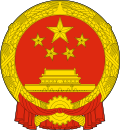Special areas (China)
Special areas ( Chinese 特區 / 特区 , Pinyin tèqū - "special zone, special region") are Chinese administrative units at district level with a special status, i. In other words, they are not urban, urban districts, districts, banners, autonomous districts or autonomous banners.
Currently, two special areas are officially listed in the national statistics as administrative units at district level. Seven more are "semi-official", i. In other words, they are listed as administrative units in the statistics at the district and provincial levels. The ultimate assignment of their status, however, is still open and is subject to a decision by the State Council.
Official special areas
The two official special areas are:
- Liuzhi Special Area ( 六枝 特区 , Liùzhī tèqū ) in Liupanshui City , Guizhou Province ;
- Shennongjia Forest ( 神农架 林区 , Shénnóngjià línqū ) in Hubei Province ; Shennongjia reports directly to the provincial government.
Semi-official special areas
The seven "semi-official" special areas are:
- four subdistricts in the Great Hinggan Mountains Administrative Region in Heilongjiang Province :
- Sub-district Jiagedaqi District ( 加格达奇区 );
- Songling subdistrict ( 松岭 区 );
- Sub-district Xinlin ( 新林区 );
- Sub-district Huzhong ( 呼中区 );
- three administrative committees in the Haixi Autonomous District of the Mongols and Tibetans in Qinghai Province :
